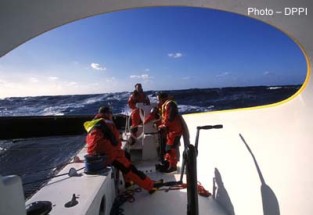Geronimo and Cheyenne fight it out on the round the world race track
Olivier de Kersauson and crew are now one-third of the way through their Jules Verne Challenge after 26 days at sea. At 0715 GMT today (Monday 22 March), Geronimo had 304 nautical miles to go before reaching the point where the longitude of Cape Leeuwin (115°08 E) is crossed by the 50°S parallel.
At the time of reporting they were still heading more or less due east (the precise heading was 86°) on the fastest possible course to this second principal waypoint and the second of the ‘Three Capes’ that occupy such an important place in the mythology of the Jules Verne Trophy.
 Meanwhile news from Cheyenne shows that at the end of day 44 she covered 526nm at an average speed of 21.92kts. After several slow days of tactical negotiation of a high pressure ridge yesterday’s speed has raised crew spirits and kept them well ahead of the record.
Meanwhile news from Cheyenne shows that at the end of day 44 she covered 526nm at an average speed of 21.92kts. After several slow days of tactical negotiation of a high pressure ridge yesterday’s speed has raised crew spirits and kept them well ahead of the record.
They are still 778nm ahead of Orange I during this stage of her record breaking challenge. A good southerly breeze should provide another good day today up the east coast of South America. From there they will need to find their way through developing weather off the Brazilian coast.
Damian Foxall on fossettchallenge.com describes yesterday’s run and the weather systems ahead:”Back into the big miles, the whole day sailing ahead of the cold front on course at 23 kts , straight down the shortest possible course. In 2002 Orange sailed a more classic wide course round and through the South Atlantic High, ultimately adding hundreds of miles to their route. We will be taking a more direct route. Past Argentina, Uruguay to Port, we are heading for a low that has formed off Rio and hope to slide up the inside, great to be downwind in this section but the low is dragging us further west than we would like which, while it is the direct and shortest route, could very easily leave us hanging out to dry once we pass close to the Brazilian coast. Anyway, in changing forecasts we sail opportunistically – and take the fast route north. Brazil here we come.”



